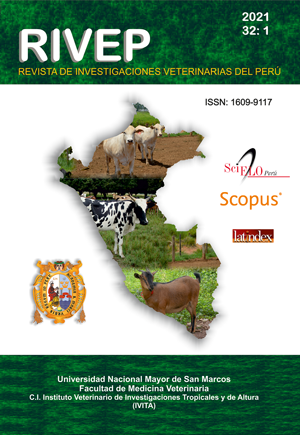Productive performance and nutritional value of seven clover genotypes in three altitudinal floors of the northern highlands of Peru
DOI:
https://doi.org/10.15381/rivep.v32i1.17690Keywords:
Trifolium pratense, Trifolium repens, chemical composition, productive performance, growth rate, altitudinal floorAbstract
The aim of this study was to evaluate the productive performance and nutritional value of seven clover genotypes at three altitude levels (PA I: 2300-2800 m above sea level, PA II: 2801-3300 and PA III: 3301-3800) of the northern highlands of Peru during a year. Four genotypes of white clover (Trifolium repens) and three genotypes of red clover (Trifolium pratense) were installed in each altitudinal floor (PA). The germination power, weight and purity of the seeds were evaluated to ensure the viability of the number of seeds sown. The yield (kg DM ha-1 year-1), growth rate (kg DM ha-1 day-1), plant height (cm) and nutritional value for each genotype were determined. The highest yields and the best growth rates (p<0.01) in the three PAs corresponded to the three varieties of Trifolium pratense (Tuscan, Americano and Relish). PA I (p<0.01) obtained the highest dry matter production (12 340.6 kg DM ha-1 year-1), followed by PA II (7808.4 kg DM ha-1 year-1) and PA III (3923.4 kg DM ha-1 year-1), showing the same trend for the growth rate (p<0.01). Crude protein levels ranged from 19.75 to 23.77% (p=0.009). The results indicate that all genotypes of Trifolium pratense and Trifolium repens should be considered as a good alternative to associate with pastures in the highlands of northern Peru.
Downloads
Downloads
Published
Issue
Section
License
Copyright (c) 2021 Luis Asunción Vallejos Fernández, Wuesley Yusmein Alvarez García, Manuel Paredes Arana, Sylvia Saldanha Odriozola, Ricardo Guillén-Sanchez, César Pinares Patiño, Julio Bustíos Valdivia, Rubén García Ticllacuri

This work is licensed under a Creative Commons Attribution-NonCommercial-ShareAlike 4.0 International License.
AUTHORS RETAIN THEIR RIGHTS:
a. Authors retain their trade mark rights and patent, and also on any process or procedure described in the article.
b. Authors retain their right to share, copy, distribute, perform and publicly communicate their article (eg, to place their article in an institutional repository or publish it in a book), with an acknowledgment of its initial publication in the Revista de Investigaciones Veterinarias del Perú (RIVEP).
c. Authors retain theirs right to make a subsequent publication of their work, to use the article or any part thereof (eg a compilation of his papers, lecture notes, thesis, or a book), always indicating the source of publication (the originator of the work, journal, volume, number and date).



